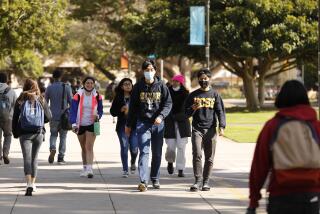Prizes Underscore UC Santa Barbara’s Quality
- Share via
SANTA BARBARA — The popular image of UC Santa Barbara is that of a party school, situated steps from the ocean and favored by surfers and beach bums.
But a lesser-known reality is emerging: Behind the doors of the physics and chemistry labs, world-renowned scientists are conducting groundbreaking research.
The two Nobel prizes awarded to UC Santa Barbara professors Tuesday are likely to bring public prestige to a university whose academic credentials have been recognized within the scientific world for decades.
“This is a glorious day in UCSB’s history,” said Chancellor Henry Yang. “It will definitely help in our recruitment and retention of top-notch faculty and brilliant students.”
Four UC Santa Barbara professors now have received Nobel prizes in the university’s 56-year history. In 1972, J. Robert Schrieffer won the prize for physics shortly before coming to the university. Two years ago, physicist Walter Kohn was awarded the chemistry prize for bringing to light the obscure inner world of atoms.
On Tuesday, engineering professor Herbert Kroemer received the physics prize for his work with semiconductors, and physics professor Alan Heeger won the prize for chemistry for the discovery of conductive polymers.
One student who saw past the laid-back atmosphere was Dan Schmidt, who attended Penn State University as an undergraduate. He decided five years ago to come to Santa Barbara for a doctorate in physics because it was then seen as an up-and-coming research university.
“UCSB doesn’t have the general name recognition that something like Harvard or Yale or Stanford or even Berkeley has,” said Schmidt, 27. “But after visiting, it looked like there was a lot of good work going on.”
Schmidt, who knows both of this year’s prize-winning professors, said the awards should let the public in on the secret that Santa Barbara truly is a first-rate university. “Having four Nobel laureates certainly brings positive attention to the UC system and to UCSB,” he said.
In the scientific community, the university is best known for its Institute for Theoretical Physics, a national facility that was founded by Kohn more than 20 years ago and runs research programs with visiting scientists from all over the world.
As a result of the innovative work being done at the institute, the university was able to woo experienced physicists from other universities. Those professors, in turn, became a nucleus for attracting students and researchers.
“It is clearly the rising technical university,” said Marc Brodsky, executive director of the American Institute of Physics. “It’s not just the Nobel prizes. The success has been very deep and broad--in engineering, chemistry and physics.”
Brodsky said the university doesn’t rank alongside such institutions as MIT and Caltech, but is becoming more and more competitive.
The university’s physics department serves about 160 undergraduate and graduate students and offers a handful of post-doctoral positions; the chemistry department has about 100 doctoral students and 275 undergraduates.
Stanley Parsons, chairman of the chemistry and biochemistry department, said the public hasn’t yet recognized the university as a center of scientific excellence.
“The image hasn’t been consistent with the reality,” he said. “We’ve had outstanding individuals on this campus for decades, living side-by-side with a party school image.”
In 1993, the campus even ranked No. 2 on the list of best party schools by Inside Edge Magazine. It also became known for its outrageous Halloween celebration that for years drew large crowds to the streets around the campus. And its location naturally drew beach-lovers and surfers, some of whom spent more time on the sand than in class.
The two prize-winning professors have been researching and teaching at the campus for years. Kroemer came to the electrical and computer engineering department in 1976, and made UC Santa Barbara one of the leading institutions for the study of semiconductors. Heeger joined the department of physics and materials in 1982, and immediately began working in both the physics and chemistry fields.
Though Santa Barbara is a beautiful place to live, Heeger said he was drawn to the university because of the collection of high-quality professors.
“What has happened here in the last 20 years is remarkable,” he said. “It’s not an accident that there are two Nobel prizes here today.”
More to Read
Sign up for Essential California
The most important California stories and recommendations in your inbox every morning.
You may occasionally receive promotional content from the Los Angeles Times.













